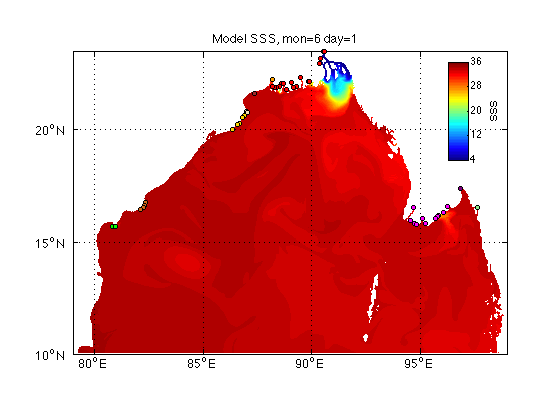ONR MISO-BOB DRI: Coupled Air-sea Interactions in the Bay of Bengal: Dynamics and Predictability of Monsoon Intraseasonal Oscillation (2017-2021)
Understanding the role of the ocean and coupled physics for the simulation and forecast models is the primary goal of the MISO-BOB DRI. The purpose of this study is to evaluate the role that the Bay of Bengal (BOB) plays in the dynamics, sensitivity, and predictability of the MISO. The project will use a regional coupled model (coupling WRF and ROMS) that is optimally configured for the MISO-BOB study with 1) an explicit deep convection for better representation of the MISO convective processes, 2) realistic prescription of the river discharge forcing, 3) highly resolved (both horizontal and vertical) mixed layer process, 4) multi-scale modeling framework for local and remote controls of the MISO, and 5) on/off control of ocean data assimilation procedures.
SMAP estimate of sea surface salinity in the Bay of Bengal Summer of 2015Using this unique modeling strategy, this study will 1) focus on the combined and relative impacts of the barrier layer dynamics and the diurnal SST variability on the MISO, 2) identify local and remote (e.g., the Arabian Sea and the tropical Indian Ocean) regions of critical importance to the MISO-BOB coupling, and 3) evaluate the controls of MISO by the large-scale climate modes of variability, and 4) examine the predictable components and predictability limit of the MISO. I will provide modeling support to the DRI with the coupled and uncoupled model hindcasts and forecasts as well as making real- time large-scale climate indicates and modified proxies for MISO available to the DRI team.
Award: $$505,185, Duration: 2017-2022
